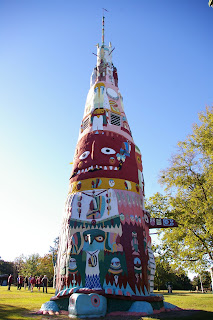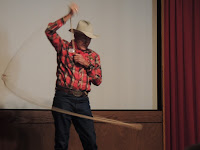 Claremore and Tulsa, Oklahoma were full of wonderful places to visit, and a motor coach bus was a great way to see the highlights.
Claremore and Tulsa, Oklahoma were full of wonderful places to visit, and a motor coach bus was a great way to see the highlights.
Our first stop was just 3.5 miles east of Route 66 --- the world's largest totem pole, built by Ed Galloway during the years 1937-1948. It is made of 100 tons of sand and rock, 28 tons of cement and 6 tons of steel but what its most interesting features are the 200 different bas-relief carved pictures. The totem pole sits on a large three-dimensional turtle and is one of several totem poles created by Galloway.


Mr. Galloway also carved violins and they are housed in the museum, or "Fiddle House", an 11- sided building which resembles a Navajo hogan.
Galloway died in 1961 and his totem poles and property fell into disrepair. It has now been acquired by the Rogers County Historical Society with a restoration effort of volunteers, art conservators, and engineers.
The Blue Whale of Catoosa has become one of the most recognizable attractions on old Route 66. The Blue Whale was built in the 1970s by Hugh Davis as an anniversary gift to his wife, but it has served as a swimming hole for locals and Route 66 travelers alike. While we were there, on a sunny cool morning, the swimming hole seemed to be a great spot for turtles.

Next, we had a delicious buffet lunch at Maxxwell's Restaurant on historic Route 66 in Tulsa.
Following lunch, we went into the adjacent Campbell Hotel. Noted for its themed rooms, each room was renovated by Tulsa's 2011 Designer showcase and was inspired by a piece of Oklahoma history. Of course, we had to take a peek into the Route 66 two room suite.

Certainly a comfortable hotel room, the decor reflected the heyday of Route 66. Nice as it was, we have our own RVs, and we're traveling Route 66 with our own creature comforts!

Enroute to downtown Tulsa, we passed by the Oklahoma state fairgrounds where a 76-foot tall Golden Driller rests his hand on a real oil derrick as he welcomes visitors. The 43,500 pound statue of an oil worker is the tallest free-standing statue in the United States and reminds us that much of Tulsa's economy is petroleum.
 Though we have not driven our RVs in the heart of major cities, we have experienced those more congested sections of Route 66, either in our cars, or by tour bus. Today we visited the Cyrus Avery Memorial Bridge in Tulsa. Known by locals as the "old 11th St. bridge", most Route 66 historical authorities have described it as the place where east meets west in America. Cyrus Avery, known as the "Father of Route 66", served as a county commissioner in Tulsa.
Though we have not driven our RVs in the heart of major cities, we have experienced those more congested sections of Route 66, either in our cars, or by tour bus. Today we visited the Cyrus Avery Memorial Bridge in Tulsa. Known by locals as the "old 11th St. bridge", most Route 66 historical authorities have described it as the place where east meets west in America. Cyrus Avery, known as the "Father of Route 66", served as a county commissioner in Tulsa.

Today the bridge has been restored and improved and was listed on the Register of Historic Places in 1996. From the bridge, we got a great view of the plaza which includes flags of the eight states of Route 66 as well as a view of the original Route 66 bridge.
Cyrus Avery was a member of the federal board appointed to create the Federal Highway System, and then pushed to establish the U.S. Highway 66 Association to pave and prom or the highway. A visionary for America!
Next we traveled to downtown Tulsa. Our very energetic guide did an outstanding job of explaining that oil is the history of Tulsa. She took us to two building built by Waite Phillips of Phillips Oil. The first was the Philcade where Mr. Phillips and his wife lived on the top floor.
There are many chandeliers in each building, purchased at $300 each. You could buy a Model A Ford for $300 at the time this building was constructed. Note the WP initials everywhere.
 The second building, Philtower Building, was built across the street. That was where Mr. Phillips’s office was located. He was concerned about security and hired a Nevada miner to dig a tunnel between the two buildings.
The second building, Philtower Building, was built across the street. That was where Mr. Phillips’s office was located. He was concerned about security and hired a Nevada miner to dig a tunnel between the two buildings.
 A few blocks away, the Boston Avenue United Methodist Church was built in 1929. It is considered to be one of the finest examples of ecclesiastical art deco architecture in the United States and has been designated as a National Historic Landmark as well as listed on the National Register of Historic Places. Designed by Dr. Adah Robinson, the church structure continues to have an active congregation and welcomes visitors for architectural tours and worship. United Methodists in our group found numerous recognizable figures and spiritual symbols on the exterior, as well as interior, of this very well-maintained church.
A few blocks away, the Boston Avenue United Methodist Church was built in 1929. It is considered to be one of the finest examples of ecclesiastical art deco architecture in the United States and has been designated as a National Historic Landmark as well as listed on the National Register of Historic Places. Designed by Dr. Adah Robinson, the church structure continues to have an active congregation and welcomes visitors for architectural tours and worship. United Methodists in our group found numerous recognizable figures and spiritual symbols on the exterior, as well as interior, of this very well-maintained church.

After this active day of touring, it seems Gunter is ready for his nap! We'll save more treasures of Claremore for tomorrow! But tomorrow is a new day, and we'll all be ready for what's next!
This retired school principal entertained us with rope tricks while he introduced us to the Will Rogers Museum in Claremore, OK. Rogers was a cowboy roper, entertainer, statesman, humanitarian, writer, political satirist, adventurer, and well-known friend to the world's movers and shakers. Born in Oologah, OK in 1879, he died in Point Barrow, AK in 1935.
The Wisdom of Will Rogers:
"If advertisers spent the same amount of money on improving their products as they do on advertising then they wouldn't have to advertise them."
"We will never have true civilization until we have learned to recognize the rights of others."
"You've got to go out on a limb sometimes because that's where the fruit is."
Our next stop was the J.M. Davis Arms and Historical Museum. Shortly after our arrival, a gun battle ensued. Fortunately it was a humorous skit and the gunmen were using blanks. And, it seems that one our caravan members was accused of crimes, and arrested by the local sheriff. Tom was, however, released for our departure!
Dinner was a special treat provided by our caravan guests Gunter and Sandy Oeser. Brats, red cabbage, sauerkraut, salad and all the trimmings! Thank you Gunter and Sandy!
Our group of Route 66 caravaners have become friends --
supportive of one another, enjoying one another's company, and happy to share a meal together! But that was not all --- Sandy created beautiful scarves for all of the ladies in the group!
 |
| Scarves for the ladies! Thank you, Sandy! |
But Wagonmaster Barry Klein thought he'd look pretty good in a scarf, too! What do you think, fashionistas? Barry did our travel brief dressed in this fine multi-colored fluffy scarf.
Claremore, OK has been a wonderful place to visit the treasures of Route 66. Tomorrow, we're off to Oklahoma City! Thanks, Claremore!
 Day 22 was a travel day with a short stop at the Route 66 Museum in Clinton, OK. Along the way, we are reminded that Route 66 is Mainstreet, USA. In El Reno,OK, a small town where automobiles were once built, there are a number of murals honoring Route 66, those who have served in war, as well as a mural of hero burial. Beautiful for those of us driving through…and even nicer for those who call El Reno home.
Day 22 was a travel day with a short stop at the Route 66 Museum in Clinton, OK. Along the way, we are reminded that Route 66 is Mainstreet, USA. In El Reno,OK, a small town where automobiles were once built, there are a number of murals honoring Route 66, those who have served in war, as well as a mural of hero burial. Beautiful for those of us driving through…and even nicer for those who call El Reno home. 



















































